Picking a paint color is just the beginning of your home painting adventure. The finish or sheen you choose matters just as much, changing the look and feel of your space and how long your paint job lasts.
Remember to repin your favorite images!
The right paint finish can really elevate a room while making life easier—think durability, easier cleaning, and even hiding little wall flaws.
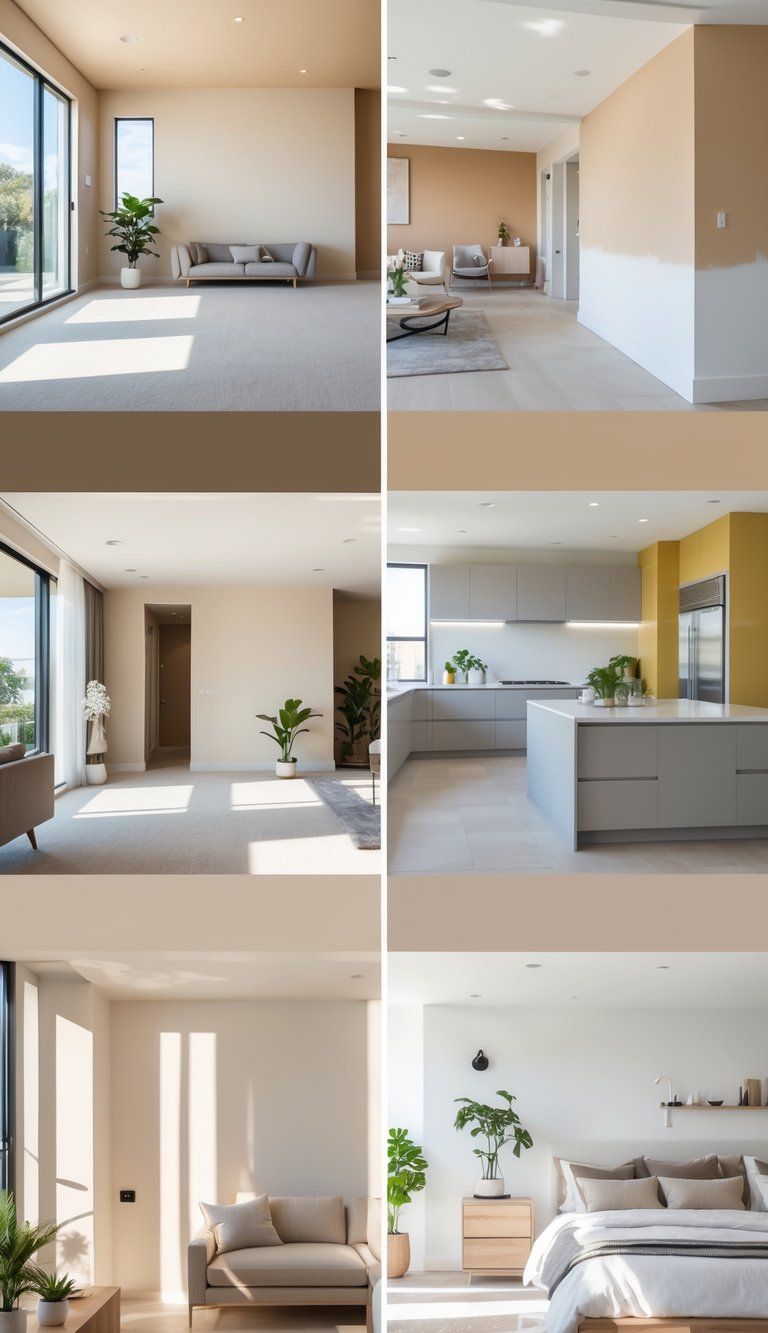
Paint finishes run the gamut from flat (no shine at all) to high-gloss that bounces light around like crazy. Each one has its own strengths. Flat finishes cover up wall problems but can be tricky to clean, while glossier options make cleaning a breeze but show every little imperfection.
How you use a room and the state of your walls should guide your finish decision. High-traffic or damp areas need something tougher and more washable. Meanwhile, ceilings or formal rooms look great in softer, flatter sheens. When you match the finish to the space, your paint job will look better and last longer.
Understanding Paint Finishes
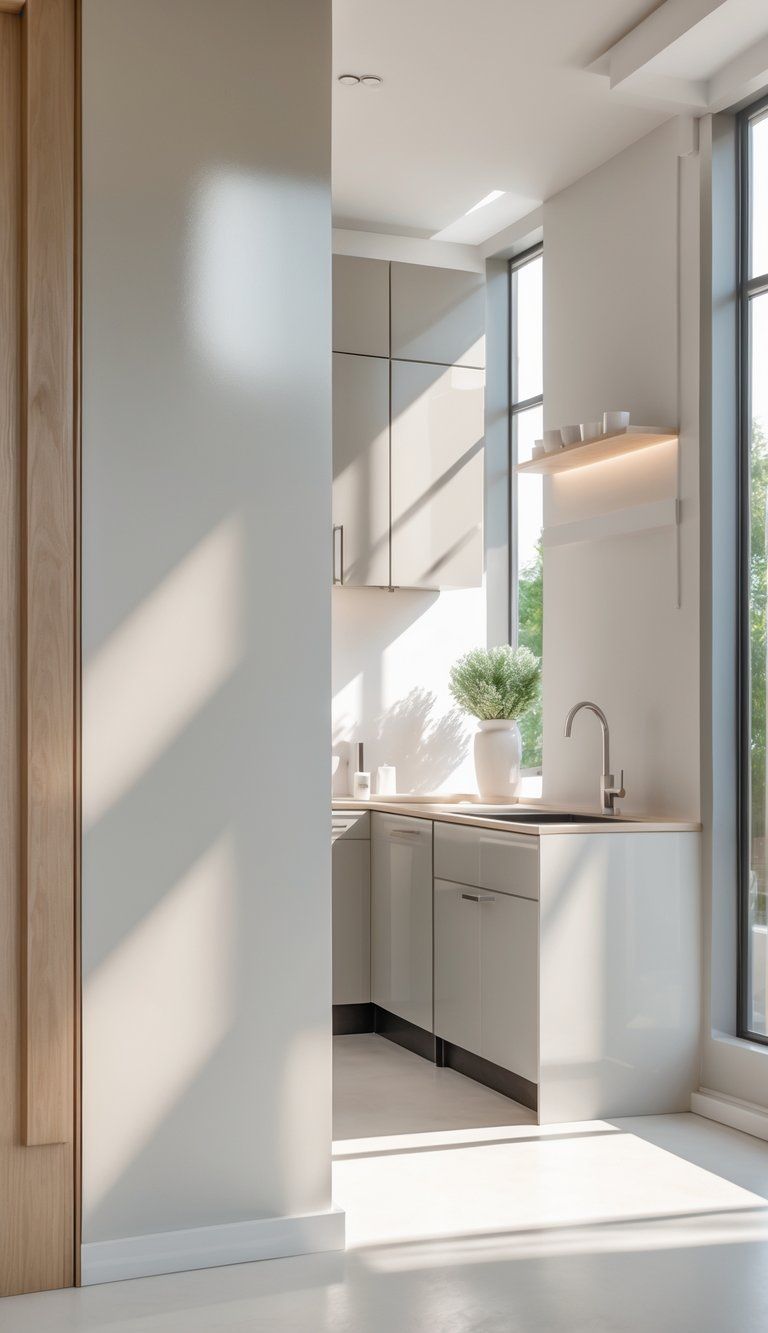
Picking the right paint finish can totally transform a room and really impact how your walls hold up. Paint finishes go from dead flat to super shiny, and each one brings something unique to the table.
What Is a Paint Finish?
A paint finish is all about how much light bounces off the dried paint. This affects both how your walls look and how they stand up to daily life.
We measure finishes by how glossy they are. That sheen changes not just the vibe of a room but also how tough the walls will be.
Higher-sheen paints shrug off moisture and are easier to clean, which is a big plus for busy rooms. On the flip side, lower-sheen paints hide wall flaws but aren’t as forgiving when it comes to cleaning.
The finish you pick can even change how colors look. The same color can look totally different in flat versus glossy paint.
Common Types of Paint Finishes
Flat/Matte: No shine here. Flat paints soak up light and hide imperfections like a champ but don’t love scrubbing. Use them in low-traffic spots like formal living rooms and ceilings.
Eggshell: This finish has just a hint of sheen, like an actual eggshell. It’s tougher than flat paint and works well in living rooms, dining rooms, and bedrooms.
Satin: Satin has a soft, velvety sheen and is more washable than eggshell. It stands up to moisture, so it’s ideal for kitchens, bathrooms, and kids’ rooms.
Semi-Gloss: This one’s durable and reflects a good bit of light. Semi-gloss is perfect for trim, doors, and anywhere that gets wet or messy.
High-Gloss: Super shiny and reflective, high-gloss paint is extremely tough but will show every little ding. Use it on trim, cabinets, or furniture if you want a bold look.
The Role of Sheen in Paint Finishes
Sheen does more than just add shine—it changes how a room feels and how well the paint holds up. Lots of sheen means more light bouncing around, making spaces brighter and colors pop.
Durability goes up with the sheen level. High-sheen paints laugh off moisture, stains, and scrubbing. If you have a busy space, go shinier.
Sheen also tweaks how colors look. Glossy finishes can deepen and darken paint colors, while matte ones can make colors look a bit lighter.
Room size and lighting matter too. Shiny paints can help small rooms feel bigger by reflecting light. If you want cozy, stick with matte in bigger spaces.
Don’t forget about the wall’s condition. Gloss shows every flaw. Flat hides them.
Factors to Consider When Choosing a Paint Finish

Choosing the right paint finish means thinking about how you want your space to look and how much abuse the walls will take. It’s all about balancing how much work you want to do, what you want the room to feel like, and what you’re starting with.
Durability and Maintenance Needs
Paint finishes aren’t all built the same. High-gloss and semi-gloss paints create a tough, scuff-resistant surface that handles cleaning and touching.
If you’ve got high-traffic areas like hallways or kitchens, you’ll want a finish that can take a beating. Semi-gloss or satin are your friends here—they handle regular wiping without fuss.
Glossier finishes need less TLC over the years since they shrug off dirt and moisture. You can clean them with normal cleaners and not worry about ruining the paint.
Flat and matte finishes aren’t as tough, but they’re great at hiding wall flaws. They really shine (well, not literally) on ceilings and in rooms that don’t see a lot of action.
Durability Ranking (Most to Least Durable):
- High-gloss
- Semi-gloss
- Satin/Eggshell
- Flat/Matte
Functionality and Room Use
Let the room’s job guide your finish choice. Kitchens and bathrooms need moisture-resistant finishes that keep mold and mildew at bay.
For bathrooms, semi-gloss or satin works best since they repel water and are easy to scrub. In the kitchen, these finishes help with splatters and grease.
Living rooms and dining spaces do well with eggshell or satin. These finishes give a little shine without being distracting and are still easy to clean.
Bedrooms and home offices are perfect for flat or matte finishes. These create a calm, non-reflective vibe that’s great for relaxing or focusing.
Kids’ rooms? Go for washable formulas in satin or semi-gloss. You’ll thank yourself when you’re scrubbing off crayon or fingerprints.
Aesthetic Considerations and Visual Appeal
Paint finish really changes the mood and color of a space. Flat finishes soak up light, making colors look deeper and richer.
Glossy finishes bounce light, sometimes making colors seem lighter and the room more lively.
Think about your style. Modern and contemporary rooms often look best with flat or matte walls. Traditional spaces usually get a little more shine, with eggshell or satin on trim and moldings.
Mixing finishes in a room adds interest. You could try:
- Flat on ceilings
- Eggshell or satin on walls
- Semi-gloss on trim and doors
Light Reflection and Wall Condition
Light can make or break your finish choice. Glossy paints reflect more light, which can help brighten dark rooms but will also spotlight every wall flaw.
If your room doesn’t get much natural light, satin or semi-gloss can help bounce light around. North-facing rooms especially benefit from this.
Older homes with bumpy walls should steer clear of glossy finishes. They’ll just highlight every imperfection.
Prep work matters more with shinier paints. You’ll need to patch, sand, and prime to get a smooth look.
If your walls are a bit rough, flat or matte finishes will hide those imperfections by absorbing light.
Best Paint Finishes for Different Rooms
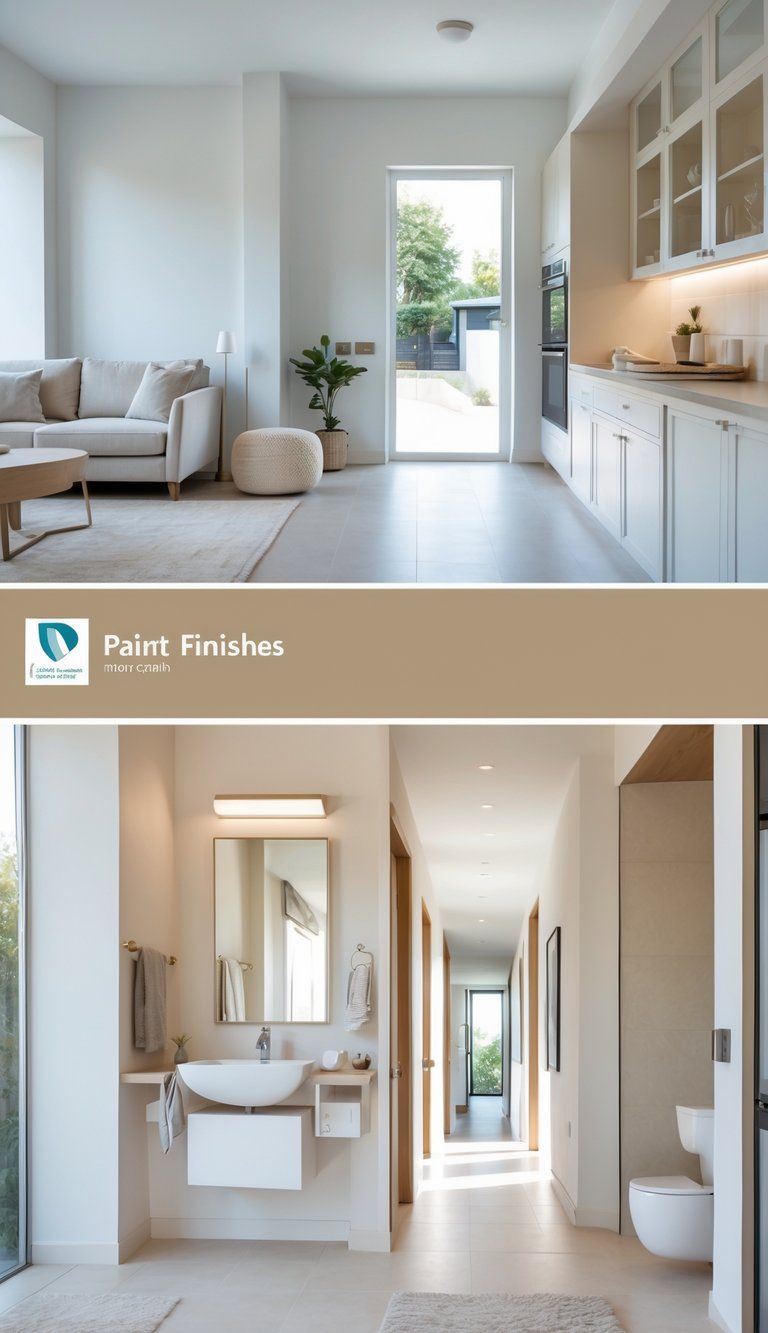
Picking the right finish for each room comes down to how you use the space and what kind of messes might happen. Each finish brings its own blend of durability, cleaning ease, and style.
Living Rooms and Bedrooms
For living rooms and bedrooms, you can’t go wrong with flat, matte, or eggshell finishes. These low-sheen options hide wall flaws and set a relaxed mood.
Flat/Matte: No shine here. Flat paint soaks up light and is perfect for:
- Adult bedrooms
- Formal living rooms
- Textured walls
Flat paint hides flaws but isn’t great for cleaning, so stick to low-traffic spots.
Eggshell: This finish has just a bit of sheen and is tougher than flat paint. It hides small flaws and is easy to wipe down now and then.
Eggshell is a nice compromise for most living spaces—great for family rooms that see some use but not constant chaos.
Kitchens and Bathrooms
Kitchens and bathrooms demand finishes that handle moisture, splashes, and lots of cleaning.
Satin: This one’s got a soft sheen and is:
- Moisture-resistant
- Easy to clean
- Durable for daily use
Satin works on walls that don’t get direct water exposure.
Semi-Gloss: With more shine, semi-gloss is:
- Water-resistant
- Mildew-resistant
- Super easy to scrub
Use semi-gloss on bathroom walls, backsplashes, and near sinks. For kitchen cabinets, semi-gloss or high-gloss are awesome since they resist grease and handle heavy cleaning.
High-Traffic Areas
Hallways, entryways, and kids’ rooms need tough paint that stands up to bumps and cleaning.
Satin: This finish is a workhorse for:
- Kids’ bedrooms
- Family rooms
- Home offices
It’s easy to clean but not too shiny.
Semi-Gloss: If you need maximum toughness, go semi-gloss for:
- Hallways
- Stairwells
- Entryways and mudrooms
- Trim and baseboards
Just remember, shiny finishes show more wall flaws, so prep those surfaces before painting.
Choosing the Perfect Paint Finish for Surfaces
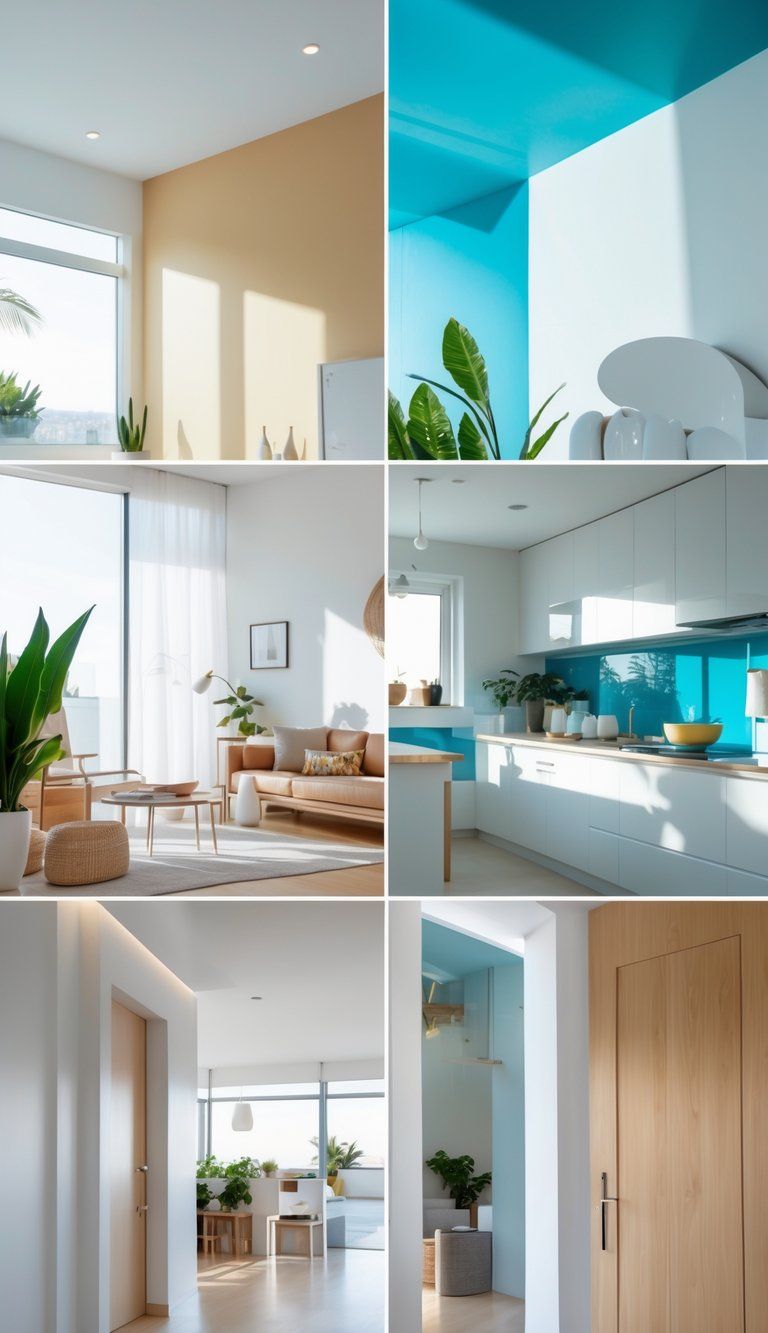
Not every surface in your home wants the same finish. The right choice makes walls smoother, trim pop, and furniture look fresh.
Walls and Ceilings
For living room and bedroom walls, eggshell finish is a solid pick. It hides small flaws and is easy to clean. Flat or matte paint works best on ceilings and in quiet rooms because it hides problems and doesn’t reflect light.
In kitchens and bathrooms, go for satin finish. These rooms get steamy and messy, so you need paint that can handle scrubbing.
Kids’ rooms or hallways that take a beating do better with satin or semi-gloss. These finishes stand up to fingerprints and scuffs, and you can wash them without worry.
Don’t skip the prep. Fill holes, sand rough patches, and clean up before you start painting.
Trim, Doors, and Cabinets
Semi-gloss and high-gloss finishes are the go-to for trim, doors, and cabinets. These spots get touched and cleaned a lot.
Semi-gloss is the most common for:
- Door frames
- Window trim
- Baseboards
- Interior doors
The shine helps these features stand out and makes cleaning easier.
For cabinets—especially in kitchens and bathrooms—high-gloss finish is king. It’s shiny, tough, and shrugs off grease and water. Sure, it shows dings more, but the easy cleaning is worth it in busy spaces.
Furniture and Low-Traffic Surfaces
Furniture and decorative pieces need finishes that suit both their function and look. For everyday items like coffee tables or desks, I’d go with satin or semi-gloss—they protect well and look good.
If you’ve got antiques or display furniture that rarely gets touched, try these:
- Flat or matte finish for that vintage vibe
- Eggshell for a bit more durability
- Satin if you want something you can wipe down once in a while
Bookshelves and display cases usually look best with a satin finish. It keeps things from getting too shiny but still guards against dust and the occasional grab.
For specialty items—think picture frames or decorative boxes—a high-gloss finish can really make them pop. Since people don’t handle these much, the shine sticks around longer and you won’t see fingerprints everywhere.
Always start with primer when painting furniture, especially if you’re switching up colors or finishes. Primer helps the new paint stick and last longer.
Detailed Comparison of Popular Paint Finishes
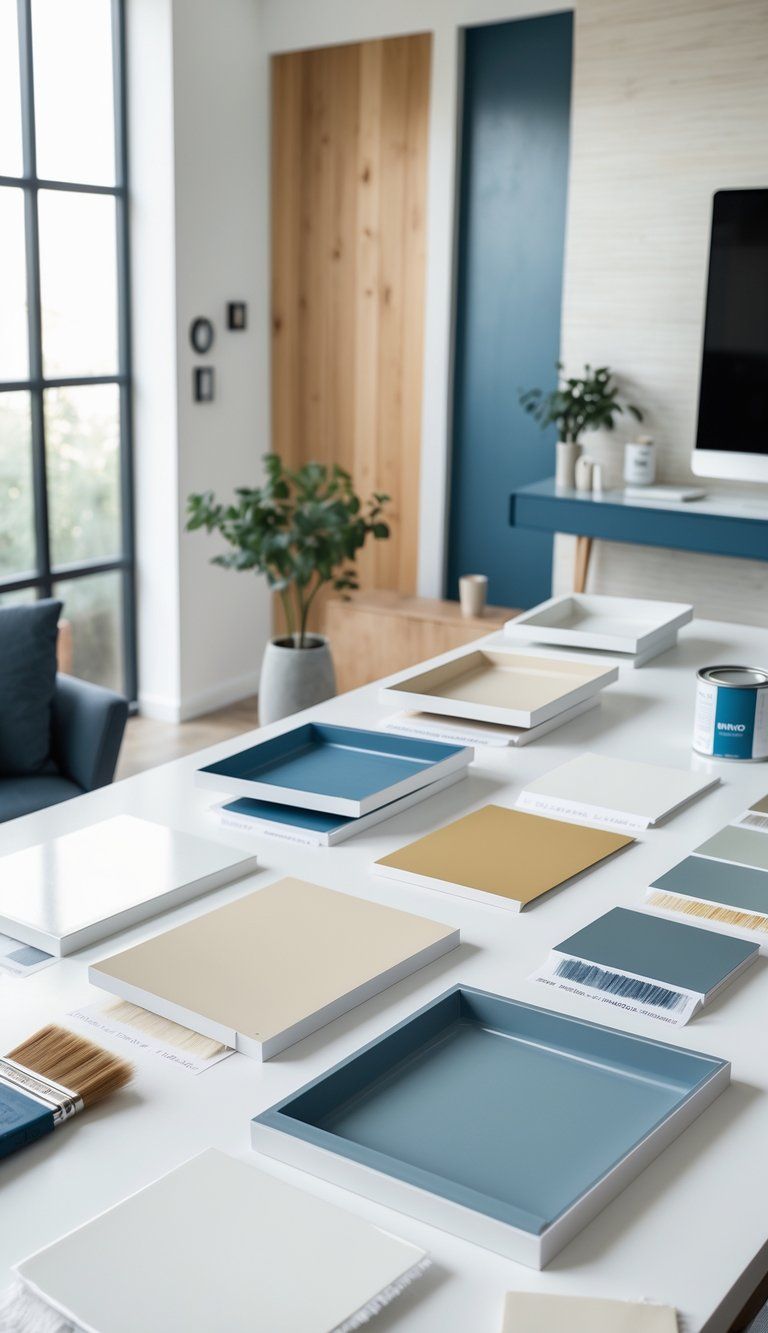
Paint finishes go from totally flat to super shiny. Each type has its own level of toughness and visual appeal. Knowing the differences helps you pick what works best for each room, depending on light, traffic, and how much cleaning you’ll do.
Matte and Flat Finish
Matte and flat finishes barely reflect light, so they give your walls a soft, velvety look. They’re great at hiding flaws and bring out rich, deep color saturation.
Best uses: Bedrooms, formal dining rooms, ceilings, and low-traffic spots.
Pros:
- Hides wall flaws and rough textures
- Looks soft and sophisticated
- Keeps glare down in bright rooms
- Usually covers in fewer coats
Cons:
- Not as tough as shinier paints
- Cleaning can damage the surface
- Scuffs and marks show up easily
Flat paint really shines in adult spaces where you’re not constantly wiping the walls. If you need to touch up, matte blends in better than glossy paint, so you won’t see patchy spots.
Eggshell Finish
Eggshell finish has a gentle sheen—think of an actual eggshell—not quite flat, but definitely not glossy. It hits a nice middle ground between durability and looks.
Best uses: Living rooms, dining rooms, hallways, and bedrooms.
Durability factors:
- Cleans up better than flat paint
- Handles moisture better than matte
- Can take moderate cleaning
Eggshell reflects just enough light to add a little depth to your walls, but it doesn’t call out every bump and dent. It works better than flat paint in busy areas but doesn’t go overboard with shine.
A lot of designers call eggshell the “goldilocks” finish—not too flat, not too shiny. It fits in almost any room and gives a bit of warmth that flat paints lack.
Satin Finish
Satin finishes have a pearl-like sheen that lands between eggshell and semi-gloss. It reflects more light than eggshell but still keeps that subtle glow.
Best uses: Family rooms, children’s bedrooms, kitchens, bathrooms, hallways, and stairways.
Key benefits:
- Super durable for busy homes
- Easy to wipe clean
- Handles moisture and mildew
- Feels warm and welcoming
Satin paint does really well in high-traffic and damp areas. The slight sheen bounces light around the room but doesn’t highlight every flaw.
Unlike flatter paints, satin lets you wipe off messes easily. It’s a go-to for homes with kids, pets, or anywhere you expect splashes and marks.
Semi-Gloss Finish
Semi-gloss finishes give you a bright, reflective surface that stands up to hard use and lots of cleaning. It adds a bit of shine and really brings out architectural details.
Best uses: Kitchens, bathrooms, trim, doors, cabinets, and places with lots of moisture.
Performance factors:
- Super tough and scuff-resistant
- Wipes clean with hardly any effort
- Resists moisture really well
- Brightens up spaces by reflecting light
Semi-gloss makes details pop and holds up against humidity, grease, and constant cleaning. It’s great for spots that get a lot of action or water.
The shine makes colors look a bit richer and more vibrant. But keep in mind, it also shows off every wall imperfection, so you’ll want to prep well.
Using Gloss and High-Gloss Finishes
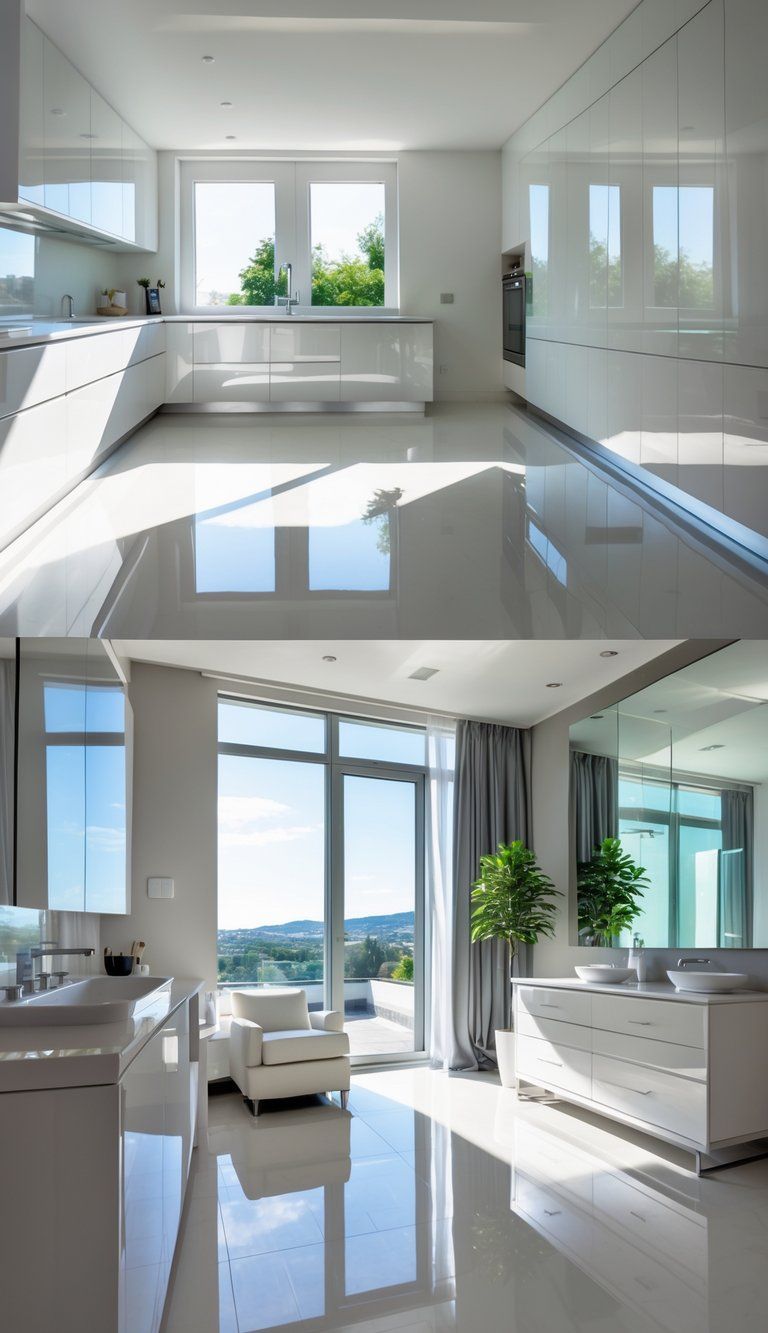
Gloss and high-gloss finishes give you the shiniest, most reflective look. They’re super durable and bounce light all over, turning plain surfaces into real eye-catchers.
High-Gloss Finish Benefits and Drawbacks
High-gloss paint creates a mirror-like, ultra-shiny surface. It’s the toughest and easiest to clean of all paint finishes, so it’s perfect for spots that need frequent scrubbing. You can just wipe off fingerprints, splatters, and all sorts of messes with a damp cloth.
Benefits:
- Toughest finish out there
- Resists moisture and mildew
- Gives a dramatic, shiny look
- Awesome for trim, doors, and cabinets
Drawbacks:
- Shows every single flaw
- Needs a lot of prep for a smooth result
- Can be too much if you use it on big walls
- Trickier to apply than other finishes
High-gloss works best in kitchens, bathrooms, and on trim where you want to draw the eye. That shine really makes details stand out.
Gloss Finish Applications
Gloss finish is a bit less shiny than high-gloss, but it still packs a punch for durability and style. It’s a solid pick for busy areas where you want protection against wear.
Best rooms for gloss paint:
- Kitchens (especially backsplashes)
- Bathrooms
- Kids’ playrooms
- Laundry rooms
Gloss paint holds up on surfaces that get touched a lot or deal with moisture. Door frames, window sills, and baseboards really benefit from its tough, easy-clean quality.
Want a modern look? Try gloss on an accent wall. The shine bounces light around and can make a room feel bigger and more lively. Gloss also looks sharp on furniture for that polished, contemporary vibe.
Addressing Surface Imperfections with Finish Choice
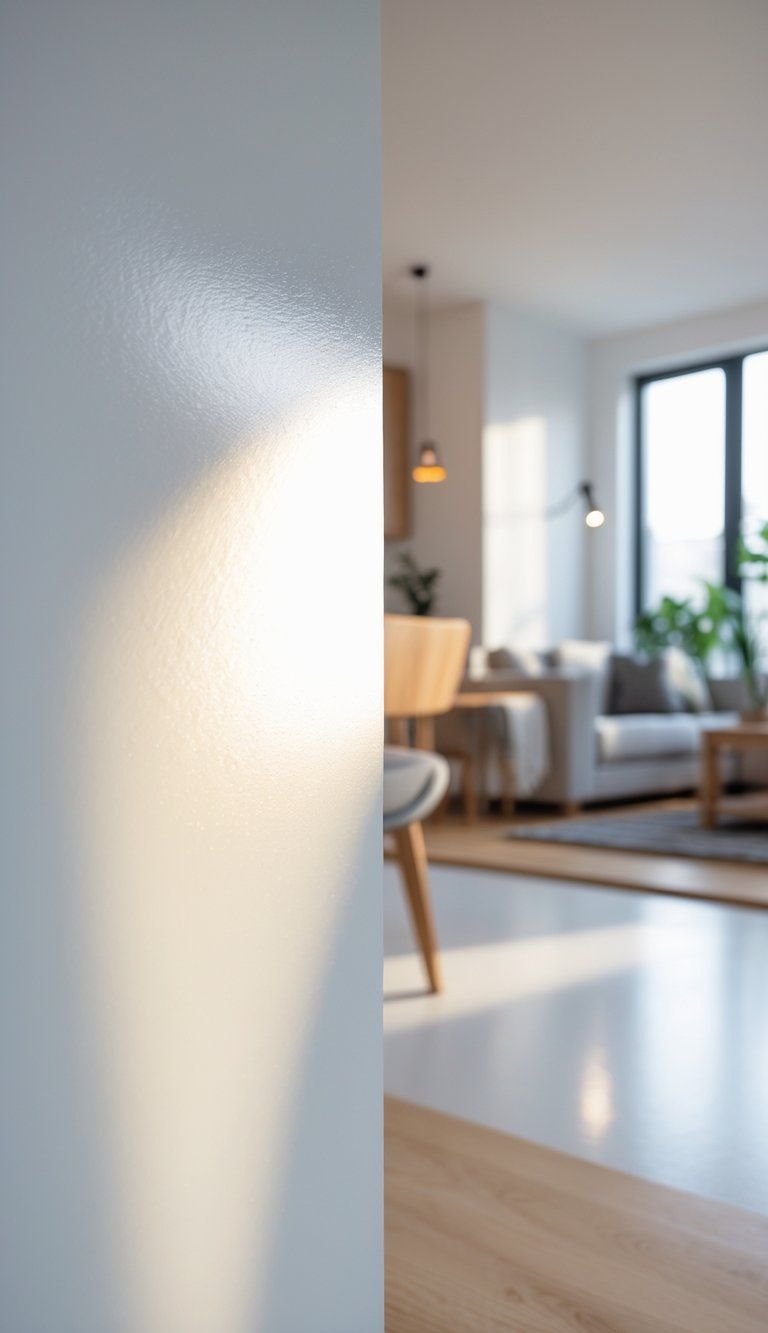
Most homes have walls with dents, patches, uneven textures, or old nail holes. These little imperfections can make things look a bit rough.
Your paint finish can help hide or highlight these flaws. Flat and matte finishes do a great job here. They soak up light instead of bouncing it around, so bumps and cracks fade into the background.
If your walls have moderate issues, here’s what I’d suggest:
- Flat/Matte: Best for hiding big flaws, but not easy to clean
- Eggshell: Hides some flaws and is easier to wipe down
- Matte Enamel: Newer option that hides flaws and is more washable than classic flat paint
You’ll want to avoid high-gloss finishes on imperfect walls. The shinier the paint, the more it spotlights every bump and crack. Glossy paints reflect light right back at you, so flaws stand out.
If you’re set on using satin or semi-gloss in a room with less-than-perfect walls, take time to fix the big issues first. Fill holes, sand down bumps, and use primer—prep makes a huge difference.
For ceilings with flaws, flat paint is almost always the way to go. It hides imperfections and keeps the ceiling looking soft and even.
Lighting plays a role, too. Rooms with strong side lighting (like a window on just one wall) will show off wall problems more than rooms with even light.
Paint Finish Selection Tips for Interior Painting Projects
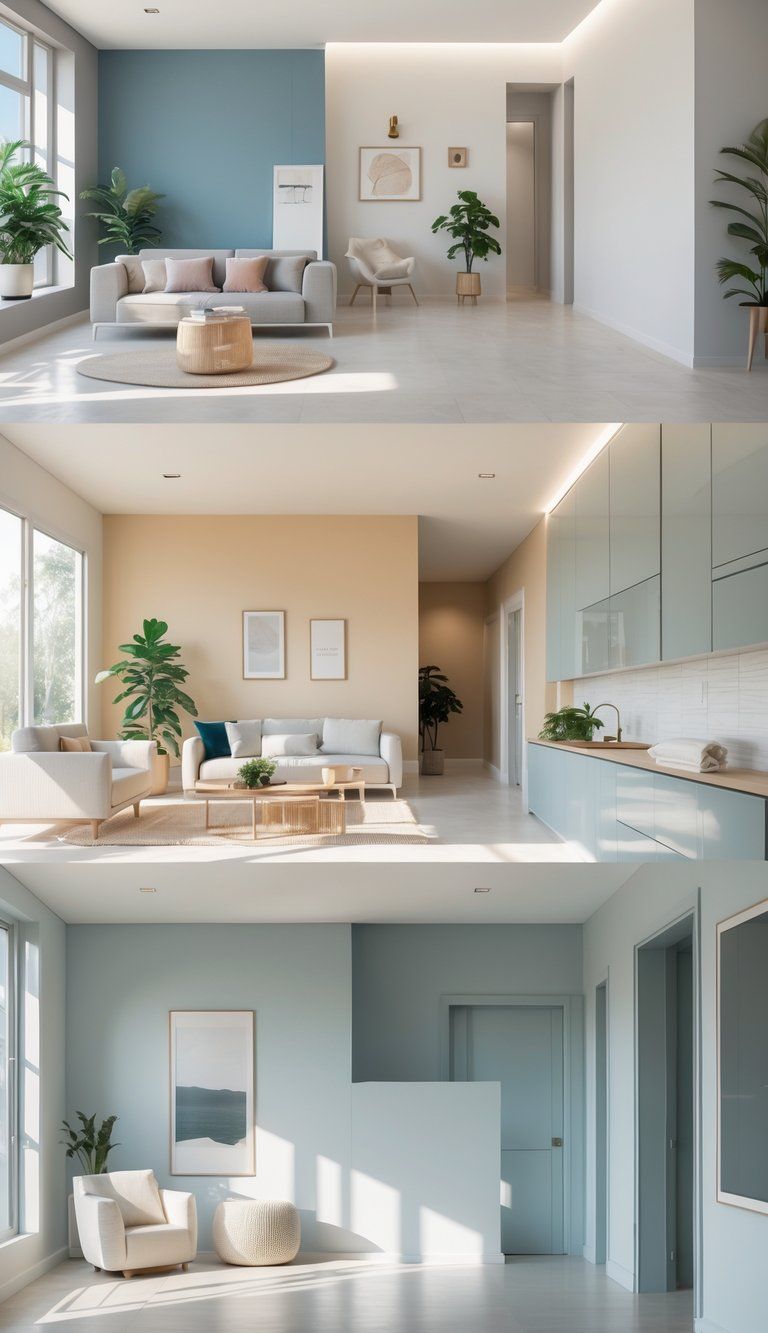
Picking the right paint finish matters just as much as choosing your color. The finish affects how the room feels, how easy it is to clean, and how well the paint holds up.
Matching Finish to Paint Color
Your paint color can look totally different depending on the finish. Dark colors usually look deeper and richer in matte or flat finishes, while lighter shades really pop with some gloss.
If you’re using bold colors, eggshell can help tone them down a bit. The slight sheen adds depth but doesn’t get overwhelming.
With neutrals, you have more options. Flat works well for beige or gray in quiet rooms, while satin makes whites and creams look cleaner and brighter.
Glossier finishes tend to highlight wall flaws, so they’re best for smooth, light-colored surfaces. Matte finishes are better at hiding imperfections, which is a lifesaver in older homes.
Importance of Prep Work
Good prep is what makes a paint job look great and last. Even the fanciest paint won’t cover up a poorly prepped wall.
Here’s what you should do:
- Fill holes and cracks with spackle
- Sand rough spots until they’re smooth
- Clean walls to get rid of dust and grease
- Use primer, especially if you’re making a big color change
- Tape off edges and trim for crisp lines
Take your time with prep, especially for glossy paints—they show every little flaw. If you skip this step, semi-gloss will highlight every bump.
In high-traffic areas, extra prep helps your paint job last longer. Clean walls let paint stick better, so your finish will survive cleaning and daily wear.
Expert Advice and Consumer Insights
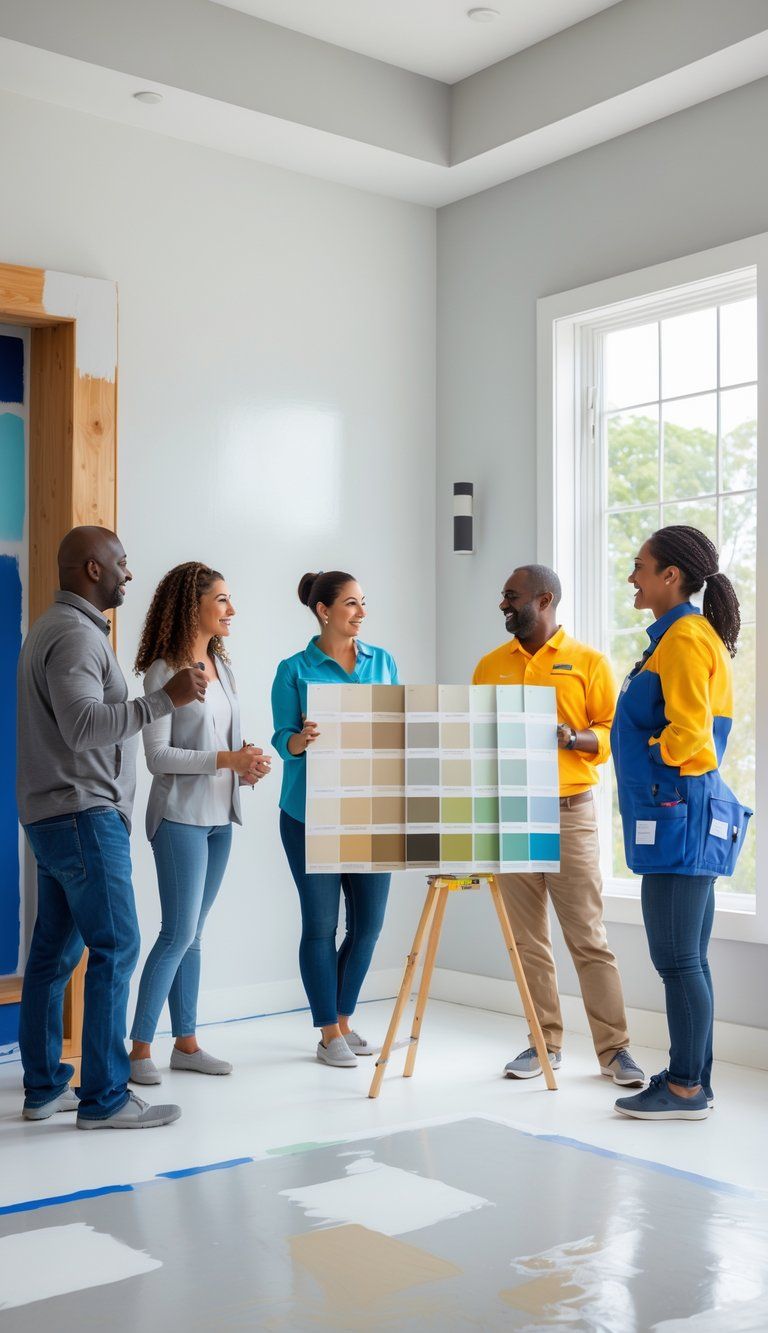
Consumer Reports points out that picking the right paint finish really comes down to two main things: natural light and the condition of your walls.
If your room gets a lot of sunlight, you can go for finishes with more shine. On the other hand, spaces with little natural light usually look better with matte finishes.
Most experts lean toward satin or eggshell for living spaces. These finishes hit a sweet spot—they’re tough enough for everyday life and still look good.
You can clean them up more easily than flat paints, but they won’t make every little wall flaw stand out like the super-glossy ones do.
When it comes to high-moisture areas like kitchens or bathrooms, pros often suggest semi-gloss or gloss.
They hold up better against water and wipe down easily after a cooking mess or steamy shower.
Here’s a simple chart to help sort out paint finish durability:
| Finish | Durability | Best For |
|---|---|---|
| Flat/Matte | Low | Ceilings, low-traffic areas |
| Eggshell | Medium | Living rooms, bedrooms |
| Satin | Medium-High | Family rooms, hallways |
| Semi-Gloss | High | Kitchens, bathrooms, trim |
| Gloss | Very High | Doors, cabinets, furniture |
A lot of professionals will tell you to try paint samples right on your wall before you decide.
Light changes everything, so check out your samples at different times of the day.
Keep in mind, shinier finishes usually last longer, but they also make wall imperfections a lot more obvious.
Think about what your home actually needs and how much wear and tear each room gets before you pick a finish.

